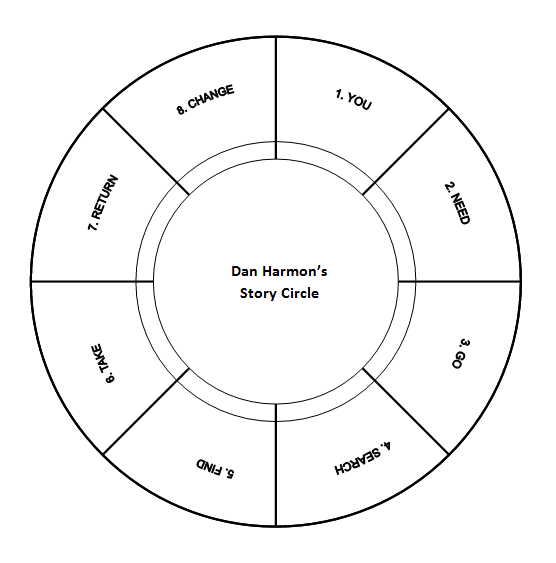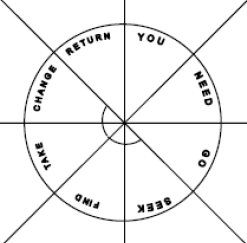[This is a lightly-edited reprint of a post on the DayTrippersRPG Subreddit, based on another post to the old DayTrippers Patreon blog.]
Vertical & Horizontal Control
Those who have read the DayTrippers GameMasters Guide know that part of the GM’s job in a “full-book” DayTrippers session is to control the “vertical” position of the narrative in runtime, regardless of the directions or actions taken by the Players (who can be said to control the “horizontal”). This approach allows the GM to provide a logical and satisfying “shape” to the emerging story, without knowing any specifics about the key obstacles or crises ahead of time.
My original method (DTGMG E1) involved the creation of a set of free-floating conditional branching elements, tracked on a “RunSheet”. Elements on the RunSheet would be called into play when triggered by actions, proximity or events, and would resolve depending on Player actions and rolls of the dice. While this approach satisfied the conditions mentioned above, it was also unwieldy in play and could easily be misused, meaning that it could too easily turn into a railroad-like structure without even trying, due to the level of specificity required in prepping it. To state it simply, I have found this approach to be unsatisfactory.
So. Over the last year or two (as of March 2017) I’ve been trying various techniques for story-mapping DT sessions, looking for another approach to replace the original “RunSheets” from version 1 of the game. This new structure would have to (a) require only a modicum of prep to get started and (b) support the emergence of a satisfying narrative arc, but it would also have to (c) allow for story development to occur in runtime, guided by the actions of the Players rather than by any “railroading” on the part of the GM.
As of today, counting the original, I’ve playtested 14 different RunSheet designs. I believe I’ve finally hit upon the one that will replace the old RunSheet when the second edition of DT comes out. Here’s an overview…
The standard narrative structure of a DT session follows a four-act episodic formula which can easily be related to Joseph Campbell’s famous “Hero’s Journey” archetypal story arc. It is particularly well suited for episodic and procedural narratives, such as those frequently found in television series.
The Harmon Circle
Years ago, Dan Harmon (Community, Rick and Morty) created a stripped-down version of this structure he calls a Story Circle, which he uses in all of his television writing. You can think of it as an abstract form or “container” for a four-act narrative structure. Typically each act hits 2 beats, giving us a total of 8 phases. As you can see below, Harmon’s eight phases go like this:
- You (a character is in a zone of comfort)
- Need (but they want something)
- Go (they enter an unfamiliar situation)
- Search (and adapt to new situation)
- Find (find what they wanted)
- Take (and pay the price)
- Return (and go back to where they started)
- Change (now capable of change)

Why?
Because in the traditional arrangement (for movies or television), once the hero has (7) returned home and (8) changed things (or proved themselves capable of change), the audience is satisfied and can turn off the TV. They have no need to dovetail the characters back into the regular routine of their lives, or to hash out the minor repercussions of the storyline they just viewed.
For roleplayers in a mission-based scenario, however, returning home is a different sort of very important step, and it involves not only returning to your regular life but also such “meta” concerns as payment, experience points, character advancement, and a bit of bookkeeping. In other words, the “Return” step really wants to happen last.
Thankfully, it also helps us to put step 8 in the 7th position. Why? Well, look at it this way: In a well-written screenplay, the visible storyline is really nothing but a symbolic veneer for interior changes undergone by the protagonist(s). But RPGs – especially mission-based or adventurous ones – don’t tend to emphasize character development as the underlying “purpose” of a session. In an RPG, any changes the characters undergo will be experienced in the heat of play, and players will enact these changes as they occur, rather than waiting for the narrative “denouement” to prove that they’ve changed. PCs don’t need to land that point safely home for the “audience” – because the group is its own audience. And this means that for a PC, it’s in the Climax where they become the greatest, most “resolved” or “heroic” version of themselves. Not after arriving home. Not after beating the Big Boss. No. Right then, while they’re facing off against the bastard. This Climax tends to happen in step 6 or (more often) 7.
Runsheet 14
So now you can take a look at RunSheet 14, and you’ll understand why the order goes like this:
- You (chargen/intro)
- Need (inciting incident)
- Go (commitment)
- Search (pinch 1)
- Find (midpoint)
- Take (pinch 2)
- Change (climax)
- Return (denouement)

Note that phases 7 and 8 have been switched, relative to Harmon’s original.
Having attained their climax in phase 7, that last phase – “Return” – is where the PCs travel home (or to wherever their home base is), experience is distributed, payment is made, effects are determined, loose ends are tied, and we wind down as a group, ready for the next session.
The top half of RunSheet 14 is designed for on-the-fly placement and tracking of events and story beats (by writing directly into the circle), while the chart below is for keeping track of PC details and experience points. This may be viewed as a rough sketch of the new RunSheet design, which will replace the old one in DayTrippers E2.
Wanna see what it looks like in use?
Check out this hot mess.

